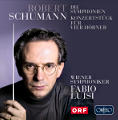ORFEO International – Reviews
Important Releases Briefly Introduced
April 2010
ORFEO 2 CD C 717 102 H
=Robert Schumann - The Symphonies
Robert Schumann the symphonist still stands in the shadow of Schumann the composer for piano and voice (the fate of Schumann the opera composer is no different). The idea that an orchestra with a great tradition of performing the Romantic repertoire should have good reason to play Schumann’s orchestral works gladly and regularly – even offering cycles of them – is something that the Vienna Symphonic Orchestra and its chief conductor Fabio Luisi have put into practice, to their credit. 
C 717 102 HThe conductor and his orchestra meet all the orchestral challenges that Schumann places before them. They play with the greatest of technical subtlety and beauty of tone, from the spirited First, the Spring Symphony, via the muted atmosphere of the Second, then the Third (the Rhenish) with its rich palette of moods and impressions, to the fantasy of the Fourth (which would have been the Second, were it not for the composer’s extensive revision of it). Schumann’s art of climax and the conclusive manner of his repetitions are here heard just as clearly as are his deft combinations of Romantic colours and shadings. Thus the fourth movement of the Rhenish (sometimes explained as a musical portrayal of Cologne Cathedral) is accorded the sacred tone that is appropriate to it, just as the “Romanze” in the Fourth Symphony is played as if it were a lover’s serenade. Fabio Luisi furthermore masters the tempo shifts and capricious quirks in Schumann’s fast movements. Here, the Vienna Symphonic plays with dizzying brilliance – and all is achieved “live”, without the safety net of the studio. To complement the symphonies, the present recording also includes the Konzertstück for 4 Horns op. 86, a powerful, vital work that stands in close proximity to the Rhenish symphony (not just in chronological terms), and which was composed during one of Schumann’s most productive periods. Schumann utilizes the form of the Konzertstück to explore those spaces between the “competitive” aspect inherent in a concertante work and the ensemble aspect of soloists and orchestra playing together as a symphonic ensemble. At the same time, the composer explores the possibilities of the modern valve instruments that themselves present further technical subtleties (and hurdles too). This work was long regarded as near-unplayable, but it is a matter of course that the horn players of the Vienna Symphonic here play it with complete, sovereign command.
top |